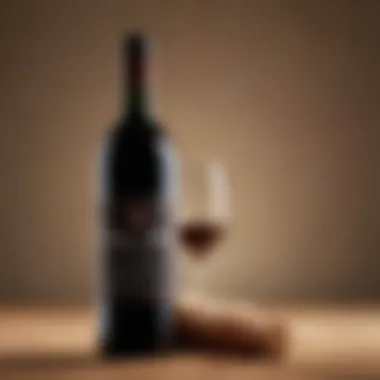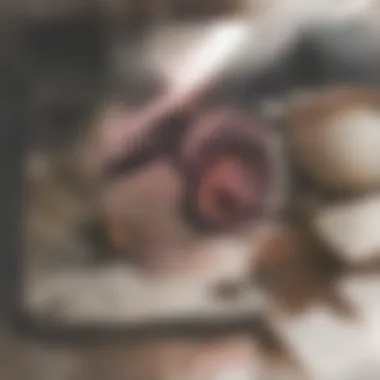Understanding Wine Openers: Resealing Corks for Quality


Intro
The world of wine is one brimming with tradition, taste, and a myriad of choices. As a wine lover, one must consider not just the varietal and vintage but also the tools that accompany the enjoyment of each bottle. Among these tools, wine openers play a crucial role, yet their capacities extend beyond mere uncorking. Understanding the resealing capability of corks is essential for maintaining the quality of opened wine.
This article delves deep into the innovative designs of wine openers capable of resealing corks after a bottle has been opened. We will explore the mechanical workings of these tools, their advantages in wine preservation, and the various types available that cater to different preferences. Additionally, we will highlight the significance of storing wine properly and how resealing helps to safeguard the wine's flavor integrity.
Ultimately, our aim is to enlighten culinary enthusiasts on how these tools can elevate their gastronomic experiences while promoting sustainable practices in wine consumption. Whether you are a casual drinker or a connoisseur, understanding the technical aspects of wine openers contributes to a more gratifying appreciation of the beverage.
Prologue to Wine Preservation
Wine preservation is essential for maintaining the quality and integrity of wine after it has been opened. The nuances of flavor and aroma can deteriorate rapidly once a bottle is exposed to oxygen. This makes understanding the methods of resealing wine, particularly through the use of specialized wine openers, increasingly relevant. When a bottle is sealed correctly after opening, it helps to retain its original characteristics, allowing enthusiasts to enjoy an optimal tasting experience over days or even weeks.
The Importance of Resealing Wine
Resealing a wine bottle serves a crucial purpose. Once a bottle is opened, the interaction with air can lead to oxidation, which can alter the wine's flavors significantly. By resealing the bottle promptly, the exposure to oxygen is minimized, helping to preserve both the taste and aroma. Wine openers designed for resealing can restore the cork to its original position or create a new seal, making it beneficial for those who drink wine sporadically. It is an act that respects the craftsmanship involved in winemaking and enhances the enjoyment of the beverage.
Impact of Oxidation on Wine Quality
Oxidation is a natural process but can have detrimental effects on wine quality. When a wine is exposed to air, it interacts with oxygen, leading to chemical changes that may spoil the wine. These changes can result in a loss of freshness, flavors turning stale, and the development of undesirable aromas. In some cases, the wine may even develop a vinegar-like taste. Understanding this process underscores the need for proper preservation methods. By using wine openers that enable resealing, wine lovers can effectively fight against the unwanted effects of oxidation, prolonging the life and enjoyment of their favorite bottles.
Mechanics of Wine Openers that Reseal Corks
Wine openers that effectively reseal corks play a crucial role in preserving wine. Understanding the mechanics behind these tools allows consumers to make informed choices. The right opener not only simplifies the process of removing a cork but also ensures that the wine can be stored properly for later enjoyment.
Design Overview
The design of a resealing wine opener is both innovative and functional. Typically, these openers employ a combination of mechanical components and materials that ensure a tight fit when resealing.
Many openers have a two-part constructed design. The first part is a spiral corkscrew that extracts the cork from the bottle. The second part involves mechanisms that compress the cork upon re-insertion back into the bottle.
Such designs are essential because the way a cork is resealed impacts its ability to maintain a proper barrier against outside elements. A tightly sealed cork can significantly reduce the amount of oxygen exposure, thereby safeguarding the wine's integrity. The careful consideration of handle shapes and gripping systems in these openers allows for a steady and strong force, making resealing a straightforward task.
How Resealing Works
The resealing process involves a few critical steps that collectively ensure that the cork fits snugly back into the bottle neck. When the cork is pulled, it expands slightly; therefore, returning the cork to its original state when resealing is vital.
- Insertion and Compression: After the cork is removed, the resealing opener compresses the cork to facilitate easier reinsertion. This is essential to ensure it does not split or break.
- Locking Mechanism: Certain models come with a locking mechanism. This feature holds the cork in place while it is being resealed, which helps maintain the integrity of the seal.
- Sealing Pressure: A proper sealing pressure is crucial. If the cork is not sealed correctly, air can find its way into the bottle, causing oxidative damage.
Proper resealing minimizes oxidation and helps maintain flavor and aroma, which is essential for the wine's enjoyment.
Overall, understanding these mechanics contributes to better wine preservation practices. A deeper knowledge of the design and functionality of resealing wine openers supports wine enthusiasts in selecting the right tool for their needs.
Types of Resealing Wine Openers
Understanding the types of resealing wine openers is crucial for wine enthusiasts. Each design offers unique features suited to different preferences and needs. With the right opener, one can extend the life of an opened bottle, maintaining the wine's aroma and flavor for a prolonged period. This section delves into three prominent types of resealing wine openers: traditional corkscrews with reseal functionality, electric wine openers, and vacuum sealers.
Traditional Corkscrews with Reseal Functionality
Traditional corkscrews have long been a staple in the wine world. However, some models are designed specifically with resealing in mind. They typically feature an improved cork extraction process that minimizes damage to the cork upon removal. This functionality provides a better seal when the cork is reinserted, thus preserving the wine's quality.
These corkscrews combine simplicity with efficiency, making them accessible to many wine drinkers. They are usually lightweight and portable, making them an excellent choice for picnics or gatherings. When using a traditional corkscrew, it is essential to make sure that the cork remains intact. Any breakage can lead to increased oxidation, undermining the product's utility.


Electric Wine Openers
Electric wine openers have become increasingly popular due to their ease of use and efficiency. They are particularly beneficial for individuals who may struggle with manual corkscrews. These devices usually employ a simple button mechanism that removes the cork with minimal effort. After the bottle is open, many electric openers come with a resealing option to easily reinstate the cork or employ a secondary sealing method. The advantages of electric models include consistency and speed. They typically work well with various cork types, including synthetic options that can be more challenging to reseal. However, it's important to consider that electric wine openers can be more costly than traditional types. Additionally, they need a power source, which might not be available during outdoor activities.
Vacuum Sealers as Wine Openers
Vacuum sealers offer a dual functionality that not only opens wine bottles but also allows for resealing after use. These devices remove air from the bottle, significantly reducing oxidation. This preservation method is particularly advantageous for maintaining the quality of wines that are only partially consumed. A notable aspect of vacuum sealers is their adaptability to different sizes and types of bottles, making them versatile tools for wine lovers. They generally provide a better long-term solution for wine preservation compared to corks alone. However, they can require a bit more investment upfront, and their reliance on mechanisms might mean users require some practice to achieve optimal results.
In summary, the type of resealing wine opener chosen can significantly impact how well wine is preserved. Each option has its strengths and weaknesses, and the choice often depends on personal preference and circumstances. By understanding these differences, wine drinkers can make informed decisions that enhance their enjoyment of wine.
Advantages of Using Resealing Wine Openers
Using resealing wine openers offers many benefits. Their main purpose is to ensure wine retains its quality after opening. The ability to reseal a bottle is critical for anyone who values flavor and aroma. By properly sealing the wine, we can slow the oxidation process, which helps maintain the drink’s characteristics.
Preserving Flavor and Aroma
One of the significant advantages of resealing wine openers is the preservation of flavor and aroma. Oxidation can quickly alter the profile of an opened wine. When a bottle is uncorked, it begins to interact with oxygen, which can lead to changes in taste. Resealing helps limit this air exposure, therefore maintaining the intended notes of the wine. Many wine enthusiasts notice a difference in a bottle that has been resealed properly versus one that has not. The complexity of flavors develops differently when oxidation is minimized. With the right tools, wine lovers can enjoy wines over days or even weeks while still retaining that first glass experience.
Cost-Effectiveness
Cost is another consideration. Wine enthusiasts often spend significant amounts on quality bottles. Resealing wine openers help in extending the life of these investments. Instead of finishing a bottle in one sitting, users can savor smaller amounts over time. This approach can also reduce waste. By keeping wine fresh for longer, we can enjoy each bottle without the pressure of having to consume it quickly.
"Proper reselaling can save you money by ensuring every sip is enjoyable, regardless of the timeline."
Environmental Impact
Environmental impact is also crucial to discuss. Resealing wine openers contribute to sustainability practices in wine consumption. By minimizing waste and reducing the number of bottles that need to be opened, consumers play a part in lowering environmental footprints. Also, many wine openers incorporate sustainable materials in their design. This clever use of resources can appeal to those conscious of their choices, allowing them to enjoy wine while caring for the planet.
In summary, the advantages of using resealing wine openers are evident. They protect the sensory attributes of wine, save money, and support eco-friendly consumption practices. With each of these points, it's clear how incorporating such tools offers tangible benefits for both casual drinkers and serious aficionados alike.
Using Resealing Wine Openers: A Step-by-Step Guide
Using resealing wine openers properly is crucial for maintaining the quality of the wine after a bottle has been opened. The ability to reseal wine bottles helps preserve the taste, aroma, and overall integrity of the wine. A step-by-step guide ensures that wine enthusiasts can maximize their experience and mitigate negative effects of oxidation.
Preparing the Bottle
Before opening a bottle, it is important to handle it with care. First, ensure that the bottle is stored upright for at least an hour. This allows any sediment to settle at the bottom if the wine is a vintage type. Next, clean the top of the bottle with a cloth. Dust and other particles can easily contaminate the wine when the cork is removed.
Once the bottle is clean, inspect the cork. If it looks dry or crumbly, it may break during the opening process. In such cases, be ready to use a two-pronged cork puller, which can help manage tricky corks without pushing debris into the wine. Additionally, if the cork smells moldy, consider not consuming the wine. This could be a sign of spoilage due to improper storage.
Opening the Wine
Opening the wine bottle requires a steady hand and a specific technique. Place the wine opener directly over the cork. Insert the spiral into the center of the cork, making sure it goes as deep as possible. A good technique is to twist the handle gently while applying downward pressure. This helps the spiral grip the cork better.
Once you have secured the cork with the spiral, pull the lever or use manual force to extract the cork slowly. Doing this prevents breaking the cork. If the cork resists, do not force it. Instead, gently twist it back and forth until it loosens. Always aim to keep the cork intact to avoid any pieces falling into the wine.
Resealing the Wine
After enjoying a glass or two, the resealing process begins. If the cork is still in one piece, reinserting it is straightforward. Hold the cork at the bottom and gently push it into the neck of the bottle. If the cork is difficult to insert, a wine stopper can be an effective alternative.
In cases where the original cork is damaged or missing, it is essential to choose an appropriate wine stopper. These stoppers can create a tighter seal compared to a compromised cork, thus reducing air exposure.


For added protection, consider placing the wine upright in the refrigerator. This reduces oxidation and helps preserve the flavor. Furthermore, investing in an ultraviolet light stopper can protect the wine from harmful light exposure, which can degrade quality.
Resealing wine properly not only extends the shelf life of a bottle but also ensures that the next glass retains the same flavors that were first discovered upon opening.
Using resealing wine openers effectively requires mindful preparation, technique, and preservation methods. Following these steps will empower both novice and experienced users to maintain their wine's integrity.
Material Considerations for Wine Openers
In the pursuit of developing effective wine openers, the choice of materials is crucial. Different materials provide diverse benefits and present unique challenges. For wine enthusiasts, understanding these factors will lead to informed decisions when selecting a wine opener. The integrity of the materials involved directly impacts the usability, lifespan, and functionality of these tools.
The right materials ensure that the wine opener can successfully reseal corks. Wine, once exposed to air, can undergo oxidation, which alters its color, flavor, and aroma. Using materials that maintain integrity helps in preserving the wine's quality after resealing.
Materials that Maintain Integrity
Wine openers often incorporate various materials, including stainless steel, plastic, and cork. Stainless steel is a popular choice due to its durability and resistance to rust. This material's strength allows for effective leverage when pulling corks. Moreover, stainless steel does not impart any strange flavors to the wine. Thus, it ensures that the wine's original taste remains intact after opening and resealing.
Another material used is food-grade plastic, which is common in lower-cost options. It is lightweight and cost-effective; however, the longevity can be an issue compared to stainless steel.
Finally, cork continues to be a reputable choice for cork stoppers in wine openers. The resilience of cork allows for a snug fit when resealing, thus minimizing oxygen exposure.
Durability and Performance
Durability is a core consideration when assessing wine openers. A durable opener withstands repeated use without losing efficiency or becoming damaged. Openers made from high-quality stainless steel generally have superior durability. In contrast, those constructed with lesser quality materials might fail after several uses.
The performance of a wine opener also hinges on its design and manufacturing quality. Slight design flaws can result in difficulties when opening or resealing bottles. Therefore, it is vital to analyze factors such as weight distribution, grip design, and mechanical components.
Comparative Analysis of Popular Resealing Wine Openers
The ability to reseal a wine bottle after it has been opened is critical for many wine enthusiasts. It directly affects the longevity and flavor of the wine. A comparative analysis of popular resealing wine openers provides valuable insights into their effectiveness, usability, and design features. Evaluating these tools not only helps consumers make informed decisions but also enhances their overall wine experience.
User Reviews and Experiences
User reviews are a rich source of information about the performance of resealing wine openers. Many wine lovers share their experiences, highlighting what works and what does not. For instance, the Ozeri O wine opener is often praised for its user-friendly design and effective sealing capability. Users report that it is easy to operate, even for those who might struggle with traditional corkscrews. On the other hand, some users have noted difficulties with certain electric models, particularly with jammed corks.
Furthermore, it is essential to consider pet evaluations. A wine opener that works well for red wines might not perform the same with delicate white wines. As one user on Reddit mentioned, "I found that my traditional corkscrew works better for my older bottles, but the electric ones are handy for casual gatherings.”
- Prosourced from users include:
- Common complaints might include:
- Ease of use
- Quick resealing process
- Effective in preserving flavor
- Mechanical issues leading to cork breakage
- Difficulty in handling certain cork types
Understanding user experiences enables potential buyers to discern which resealing opener suits their preferences and needs.
Price Point and Value
Pricing varies significantly among resealing wine openers. Some basic corkscrews cost less than $20, while advanced electric models can exceed $100. It is essential to assess whether the price reflects the quality and functionality of the product.
When examining price versus value, consider the following factors:


- Quality of Materials: Opener made from durable materials often delivers better performance. For instance, stainless steel options tend to withstand wear and tear compared to those made from plastic.
- Features: Additional features, like battery life for electric models or ease of cleaning for manual openers, can justify a higher price. Customers sometimes suggest that an initial investment in a higher-end product can lead to better long-term savings.
- Longevity: Buying a cheaper model might seem appealing, but users report needing replacements, which can add up over time.
Challenges and Limitations
Understanding the challenges and limitations of wine openers that reseal corks is crucial. These factors can greatly affect the overall performance and user experience. Addressing these challenges ensures that wine enthusiasts can make informed decisions when selecting the right tool for their needs. Emphasizing these limitations helps in understanding what specific aspects can influence both the taste and storage of wine.
Mechanical Issues
Mechanical issues often arise with wine openers, particularly those designed to reseal corks. These problems can include misalignment during the resealing process, breakdown of mechanical parts, or even wear from repeated use. Issues with gear alignment may prevent the cork from sealing properly, leading to potential oxidation, which can ruin the wine. Furthermore, users may experience difficulty in operating the device due to its complexity or stiffness. Regular maintenance and inspection of these tools can be key to mitigating some of these mechanical challenges. Understanding the mechanics can prevent frustration and enhance user satisfaction.
Compatibility with Various Corks
Compatibility presents another challenge for resealing wine openers. There are several types of corks on the market, including natural corks, synthetic corks, and screwcaps. Each cork type has unique characteristics, affecting how well it can be resealed. For instance, natural corks may compress and lose elasticity over time, leading to less effective resealing. On the contrary, synthetic corks can have different moisture retention properties. Users may find that certain openers work well with one type but struggle with another.
Choosing an opener that is versatile enough to handle multiple cork types can ensure better performance. Therefore, evaluating specific product capabilities and recommendations from users helps in selecting an effective resealing tool that matches various cork styles. Being aware of these compatibility challenges allows for better long-term wine preservation and enhances the overall experience.
Future Trends in Wine Preservation Tools
The landscape of wine preservation is evolving rapidly due to innovations in technology and growing consumer awareness about sustainability. This section explores how advancements will influence wine openers and the strategies for maintaining wine quality over the long term. Understanding these trends enhances wine enthusiasts' ability to choose effective tools that align with their values and tastes.
Smart Technology in Wine Openers
Smart technology is becoming an integral part of the wine experience. Today's wine openers are not just manual gadgets; they are being designed with features that engage with the user in a more intelligent manner. These devices often come with apps that help track wine inventory and suggest food pairings. Moreover, they can monitor the wine's exposure to air after opening, which enables users to know the best time to finish a bottle.
Key features of smart wine openers include:
- Bluetooth Connectivity: Sync with smartphones to manage wine collections.
- Preservation Alerts: Notifications on when to consume open bottles.
- Flavor Profiles: Suggestions on how to preserve the wine's unique essence.
Such innovations allow for a seamless interaction with the tools, enhancing the overall experience of wine enjoyment. With the rise of AI technology, these devices can even learn user preferences, providing personalized suggestions and improving the artistry of pairing wine with food.
Sustainable Practices in Wine Packaging
As environmental concerns grow, many companies are shifting to sustainable practices in wine packaging. The choice of materials not only impacts the environment but can also influence the preservation of wine. Traditional glass bottles are heavy and resource-intensive to manufacture, leading to a demand for lighter and more eco-friendly options.
New developments include:
- Eco-Friendly Materials: Recycled and biodegradable materials are slowly entering the mainstream.
- Innovative Caps: Resealable caps and closures that can help maintain wine quality without harsh environmental impacts.
- Reduced Packaging Size: Smaller packaging options that are easier to transport while keeping the wine fresh.
These practices not only aim to reduce carbon footprints but also encourage a broader conversation about how wine lovers can contribute to environmental sustainability. The integration of sustainability into production and packaging demonstrates a commitment to not just wine quality, but the health of the planet as well.
End
In this article, we have delved into the nuances of wine openers and their crucial role in resealing corks. The ability to properly reseal wine after opening is not just a matter of convenience; it directly impacts the preservation of the wine’s quality and flavor. Being able to extend the lifespan of an opened bottle fosters a more enjoyable wine experience for both casual drinkers and connoisseurs. Understanding the mechanisms and types of wine openers enhances user interaction, encouraging thoughtful wine preservation practices.
Summarizing the Benefits
Resealing wine provides several key benefits that should not be overlooked:
- Flavor Preservation: By minimizing oxidation, wines maintain their intended palate, aroma, and complexity. This is especially important for high-quality wines that require careful handling to fully appreciate.
- Cost Efficiency: Using a quality wine opener that can reseal bottles helps in getting more value from each bottle. It eliminates waste and allows consumers to enjoy wine over several days or weeks without deterioration.
- Improved Storage Practices: Investing in specialized wine openers reinforces the idea of proper wine storage. Resealing enhances the wine's condition, making it suitable for longer shelf life even after opening.
Encouraging Informed Choices for Wine Enthusiasts
For wine enthusiasts, making informed choices about wine openers is essential. Several factors should be considered:
- Research Options: Investigate different brands and models. Understanding the unique features of openers can guide users to a suitable choice that fits their specific needs.
- User Reviews: Feedback from other users can provide insights about the reliability and efficiency of the opener. Visit platforms such as Reddit or Facebook to explore discussions and personal experiences.
- Sustainability Considerations: Seek openers that align with sustainable practices. This is important not only for personal values but also for promoting environmental responsibility in wine consumption.
By considering the aspects mentioned above, wine lovers can enhance their experiences while also encouraging practices that safeguard the richness of wine for the future.







